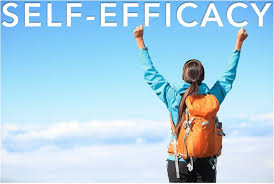Self-efficacy, health and reappraisal
Self-efficacy has proven to be an important concept in the chase of understanding and predicting what we do, and what we don’t. Bandura (1994, p.1) defines perceived self-efficacy as
“… people’s beliefs about their capabilities to produce designated levels of performance that exercise influence over events that affect their lives. Self-efficacy beliefs determine how people feel, think, motivate themselves and behave. Such beliefs produce these diverse effects through four major processes. They include cognitive, motivational, affective and selection processes.” (Bandura, 1994)
Research has shown that self-efficacy is an important construct in many health behaviours, and it is widely seen as an important part of creating short- and long-term changes in health related behaviour. “Higher self-efficacy has been related to less addictive behaviors (Diclemente et al., 1995), lower physiological stress responses (O’Leary & Brown, 1995), and lower relapse rates of smoking cessation (Gulliver, Hughes, Solomon, & Dey, 1995). Additionally, greater self-efficacy is related to better adherence to a medical treatment regimen (Dennis & Goldberg, 1996; Rosenbaum & Smira, 1986).” (Maher, 2014)
Persons with high (trait) self-efficacy see the world as a place with challenges that they can learn to master, persons with low self-efficacy see the world as a possibly threatening place and experience setbacks as a personal failure from which they find it hard to recover. Belief in self-efficacy can be promoted in four ways (Bandura, 1994, 2004, 2006)
1) Mastery experience,
2) Social models,
3) Social persuasion and
4) Reappraisal of somatic and emotional state.
The experience of our own success builds up our perceived self-efficacy while experiencing failure lowers our perceived self-efficacy. However, if our successes are too easily achieved we do not learn any efficacy in the face of obstacles and our built up perceived self-efficacy collapses at the first unexpected setback. A robust sense of self-efficacy comes from the experience of overcoming obstacles; mastery is something that requires effort and leads to success.
Through the observed efforts and results of others we influence what effort we expect to lead to what results in our own behaviour. This social modelling depends highly on the perceived similarity between the social model and ourselves; the more similar we judge them to be to ourselves, the more our perceived self-efficacy shifts depending on the efforts and results of the model. We look for models that display the skills we desire and try to learn ways to achieve such skills from them, leading to a higher sense of perceived self-efficacy.
Persuading people that they are capable of mastery can heighten perceived self-efficacy in the sense that it can lead to a short-lived increase of effort and commitment, whereas people might have given up without such persuasion, resulting in a successful mastery experience. However, it is easier to undermine self-efficacy through social persuasion than it is to promote is. Psychological boosts are easily deflated by reality and do not provide any resilience over time. Social persuasion is more successful when it focuses on teaching people how to structure situations to maximize the chance of success and measuring success in terms of self-improvement instead of comparison to others.
We tend to interpret our physical responses and our mood-state as related to our capabilities, while this need not be the case. Persons with a high sense of self-efficacy can interpret a state of arousal as a motor to action whereas persons with a low sense of self-efficacy can interpret the same state as an obstacle to action, or even an indication to cease all efforts. Since these are the same states, it is not so much the occurrence but the interpretation that determines its’ influence on perceived self-efficacy. The interpretation of such physiological indicators appears to be most important when it pertains to health functioning and physical activity.
One experiment that follows the line of Reappraisal of somatic and emotional state is the work of Alison Wood Brooks (2013) “Get Excited: Reappraising Pre-Performance Anxiety as Excitement”. She conducts several experiments in which participants are faced with tasks that make them anxious and are prompted beforehand – or prompt themselves – either with “I am calm” or with “I am excited”. The calm-prompt follows the usually taught response to being anxious, which is to try and calm down. In these experiments Brooks consistently found that the participants with the excited-prompt performed better on their tasks while remaining highly aroused, this was measured by raised heart rates throughout, as compared to the calm-prompt participants (Brooks, 2013).
References:
Bandura, A. (1994). Self‐efficacy: Wiley Online Library.
Bandura, A. (2004). Health promotion by social cognitive means. Health education & behavior, 31(2), 143-164.
Bandura, A. (2006). Toward a psychology of human agency. Perspectives on psychological science, 1(2), 164-180.
Brooks, A. W. (2013). Get Excited: Reappraising Pre-Performance Anxiety as Excitement.
Maher, K. (2014). The effect of youth diabetes self-efficacy on the relation among family conflict, disease care and glycemic control. (PhD Dissertation ), Virginia Commonwealth University.

